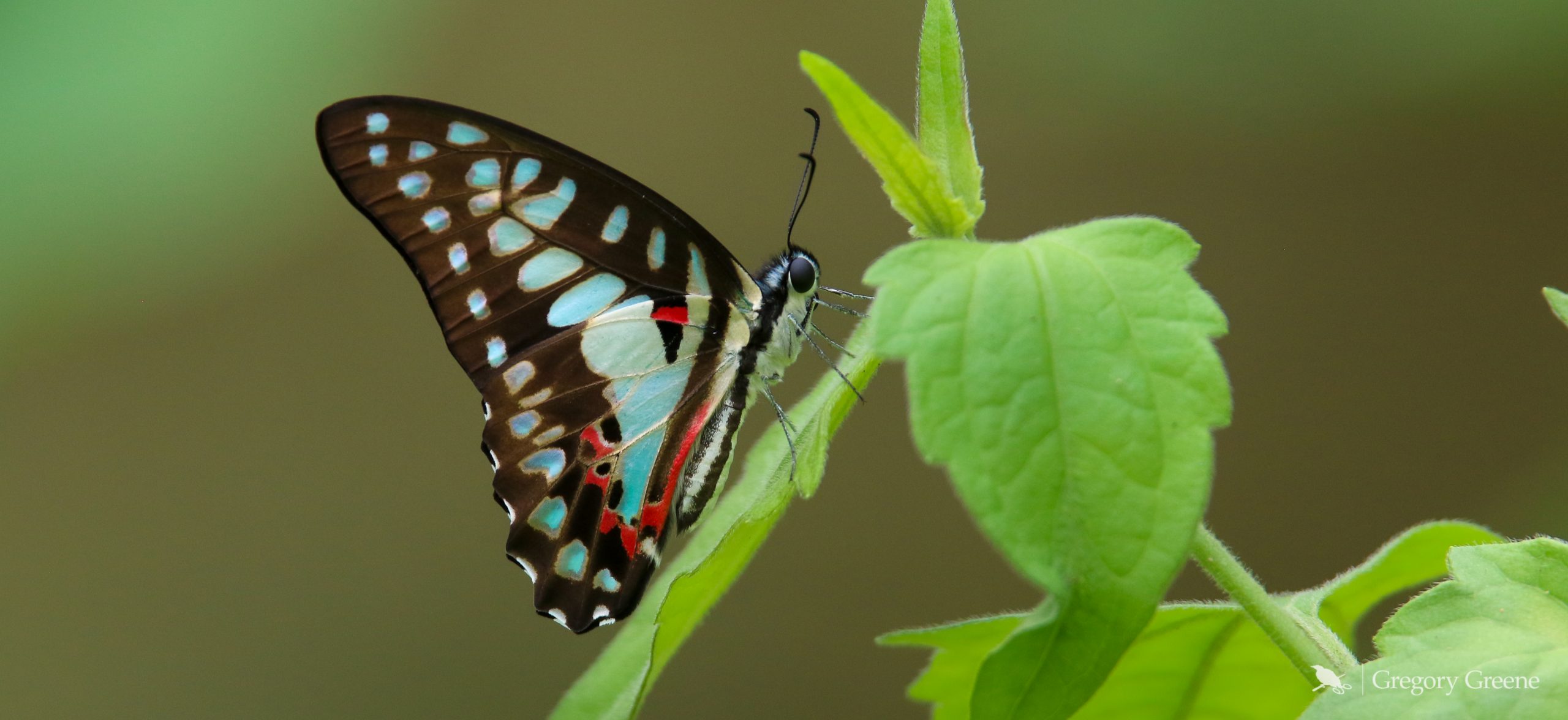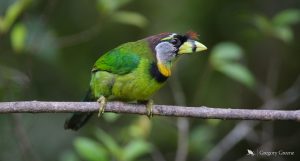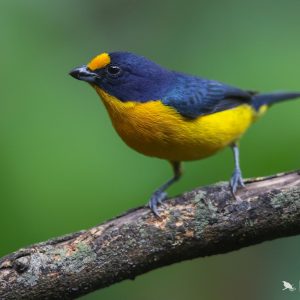
CENTRAL & SOUTHERN THAILAND: February 2019
Our trip this year to southern Thailand enjoyed good weather and many birds, some 300 species. Our time at Kheng Krachan National Park was crimped a bit as the monsoon from the previous summer had closed the road to higher elevations. The one plus was that we had more time in the blinds where we had a number of key species. Highlights included 39 species of shorebirds including the rare trio of Spoon-billed Sandpiper (just one, but well seen), Asian Dowitcher, and Nordmann’s Greenshank plus White-faced and Malaysian Plovers and Eastern Curlew. We did very well with gallinaceous species noting Silver Pheasant, Siamese Fireback, Bar-backed, Ferruginous, and Scaly-breasted Partridges and a male Gray Peacock-Pheasant. At Khao Yai National Park we saw all four hornbill species, including Northern Brown. Scarcer species included Oriental Darter, Indian Thick-knee, Slaty-legged Crake and Rufous-winged Buzzard. Rarities includ ed a Himalayan Griffon and the country’s first Sacred Kingfisher. Mammals included two Yellow-throated Martins, nice views of multiple wailing White-handed Gibbons, and a scarce Indochinese Serow.
Our tour began with a meeting in the lobby of the Novotel, followed by dinner. The next morning we left just before dawn for Rangsit, a small marsh near the old airport. Here we saw good numbers of Lesser Whistling-Ducks and Pink-necked Green Pigeons and also saw Yellow Bittern, Purple Heron (several), Grey-headed Swamphen, Bronze-winged Jacana (five), Dusky, Black-browed and Oriental Reed Warblers, Yellow-bellied Prinia, White-shouldered Starling, White-rumped Munia, and a dozen Yellow-vented Bulbuls. A male Siberian Rubythroat was unusual as was a Rufous-winged Buzzard. Notable too were three Eastern Yellow Wagtails (macronyx). This is a declining species in Asia (and Alaska). Our next stop was Wat Chalarm Praket where we had both Spotted and Asian Barred Owlets, and Red-breasted Parakeets. At Wat That Sung, we noted 100’s of Lyle’s Flying Foxes and 15 Long-tailed Macaques. Along the way we saw nesting Baya and Asian Golden Weavers. Our lunch at Ayutthaya, the old capital city prior to its sacking by the Burmese in 1767, was highlighted by our spotting of a Pied Kingfisher across the river. Our last top was at Wat Pra Buddha Bat Noi, a site for Limestone Wren-babbler, but sadly we were unable to find them late in the day. We overnighted not far from the north entrance to Khao Yai National Park.
On our first day in the park we headed up to Khao Khaeo. At the checkpoint we had excellent views of two Black-throated Laughingthrushes and Common Green Magpies, and noted several Bared Cuckoo-Doves flying over. Two Olive-backed Pipits and a Gray-backed Shrike were present too. Nearby on the trail to the overlook at Pha Bieo Bai, we found both Silver-breasted and Long-tailed Broadbills, Marten’s, Sulphur-breasted, and Radde’s Warblers, and Bar-winged Flycatcher-shrike. A juvenile Rufous-bellied Eagle was spotted flying over. Probably the most notable sighting was an Indochinese Serow, a scarce Asian antelope. This is the first time I’ve ever seen this species in Asia in some 30 trips. Highlights in the park lower down included Red Junglefowl (4), Common Snipe (good scope studies near headquarters), both Oriental (including nest) and the scarce Northern Brown Hornbill (seven), Swinhoe’s Minivets (many), Chestnut-headed Bee-eater, White-bellied Erpornis, Buff-bellied Flowerpecker, and Golden-fronted Leafbird. Other mammals for the day included good views of White-headed Gibbons (also heard Pileated Gibbon) and numerous Pig-tailed Macaques, a real nuisance. A green colored pit viper curled up in a tree at headquarters, may have been Vogel’s Pit Viper.
The next morning we stopped along the highway in the park at a fruiting fig tree. Thick-billed Green Pigeons were in abundance and we had good views of Great and Wreathed Hornbills. Two Greater Flamebacks were present and we admired the spectacular Black Giant Squirrels. While watching the “show” in the trees above, a Yellow-throated Martin appeared on the side of the road, and then darted back into the forest. After a few minutes it reappeared and crossed the road. A very short time later, its companion crossed too. It is the first time I’ve seen this large striking martin before. It has a wide range in Asia with multiple subspecies. Later in the day after lunch we headed out of the park and northeast to Sokaerat Environmental Biosphere Reserve and Research Station. This is a good location for Siamese Fireback and we were eventually able to find them, seven in all, and had excellent views. Later at the centr, one of the researchers brought out a Monocled Cobra that they were studying and gave us a detailed life history of the species as it raised up to view us. We kept our distance!
This morning we again ascended the high ridge of Khao Khaeo. Before reaching the ridge a pair of Silver Pheasants were spotted in the road and stayed long enough for all to see well. Other species of note included a male Black-throated Sunbird and an Orange-breasted Trogon. After lunch we headed to the south end of the park to the Lam Thkong River. There we had a Violet Cuckoo, a male Van Hasselt’s Sunbird, and a male Hainan Blue Flycatcher. We finished the day by the side of the pond at the old accommodation in the park. Near dusk, we hung out at the pond to wait for needletail swifts, which often come into drink before going to roost. We were not disappointed and had excellent comparisons of both Sllver-backed and Brown-backed Needletails, the latter being much more numerous.
We left early the next morning for the long drive to Kheng Krachan National Park. We stopped at a raptor site at Phkk Phli paddies. Here we had hundreds (300 estimated) of roosting Black Kites. A Greater Spotted Eagle was briefly seen. Other species seen included multiple singing Striated Grassbirds and Oriental Skylarks, a pair of Plain-backed Sparrows (and nest), a male Red-throated Pipit and an Oriental Pratincole. The primary reason we went there was to see a juvenile Himalayan Griffon, a rare vulture that is found to the north, and which had been wintering here, and was periodically appearing. At mid-morning it appeared high overhead. Despite the distance, its huge size made it easily identifiable. A Peregrine Falcon was also seen. From here it was a long drive to Kheng Krachan. Late in the afternoon we got into a hide to try for a Blue Pitta but were not successful. A Pale-legged Leaf Warbler was seen well.
Our time in Kheng Krachan National Park was spent entirely at lower elevations. Sadly, during the monsoon season the previous summer the road that went up to the crest at 1000 meters was washed out and the damage had not yet been repaired. So, we spent much of our time working the entry road to and slightly beyond the headquarters. The one advantage was that it did give us more time in the blinds to look for secretive species. Our time in the blinds was very productive. The first morning we carefully birded along the main road, stopping first at a roosting site for Black-thighed Falconet. We saw three. Other birds of note that morning included multiple Greater and Common Flamebacks, Stripe-breasted Woodpecker, Black Baza, Grey-rumped Treeswift, Large Woodshrike, and Baker’s Bulbul, a recent split from Grey-eyed Bulbul. Banded Langurs were much in abundance. That afternoon in the blind we had excellent studies of three partridges: Bar-backed, Scaly-breasted and Ferruginous. Seeing these species away from a blind is highly unlikely and even in a blind, one has to be very lucky to see them all. Other species noted included Brown-cheeked Fulvettas (20), and a male Indochinese Blue Flycatcher. The tiny Lesser Oriental Chevrotain (formerly called the Lesser Mouse Deer) also visited.
The next morning we worked the entrance road again seeing pretty much the same slate of species as the previous day. New additions included an Eastern Crowned Warbler and two Silver-breasted Broadbills. We also saw an Asian Vine Snake. The next day we worked the road again and the trail above the headquarters. We added a few new species. These included Racket-tailed Treepie, Greater Yellownape and Black-naped Woodpecker (not seen by all), Blue-bearded Bee-eater, Sultan Tit, Ruby-cheeked Sunbird, and Thick-billed and Yellow-vented Flowerpeckers. Eight Great Hornbills, and another male Chinese Blue Flycatcher was seen and overhead we noted three Pacific Swifts. Also, an Eared Pitta was heard. Also notable near the entrance to the park were a group of the very distinctive Stump-tailed Macaques. That afternoon we visited a blind where we enjoyed multiple laughingthrushes. White-browed Scimitar Babbler, and White-crested, Lesser Necklaced, and Greater Necklaced Laughingthrushes, were all seen well. Two Large Scimitar Babblers made a brief appearance. Our best birds though were a male Grey Peacock-Pheasant that spent over ten minutes drinking from a pool in front of the blind. Then, just at dusk, Nigel spotted a crake walk in, a juvenile type Slaty-legged Crake. It stayed for all whom remained in the blind got to see. This is the first time we have seen this species on one of our Thailand tours.
The next morning, we birded one final time along the road at Kheng Krachan N.P., then headed to Kheng Krachan Country Club. Species of note included Crested Goshawk, a male Asian Emerald Cuckoo, Chestnut-breasted Malkoha and an Arctic Warbler. Around a pond at Kheng Krachan Country Club we were able to find a pair of Indian Thick-knees, a split from the Stone Curlew from Europe. We have not encountered this species previously in Thailand. Oriental Darter was also present as were two Rufous Treepies. After lunch there we headed to Fisherman’s Village Resort on the west coast of the Gulf of Thailand and our home for the next three nights. We ventured up to Phak Thale, but the tide was out and shorebirds were few. We spent most of our birding time at the Royal Project near our hotel. We sorted through the various mynas coming into roost, counting some 250 White-shouldered Starlings. Two Javan Pond Herons coming into alternate plumage and a Ruddy-breasted Crake were seen.
The next morning we visited Phak Thale to search for Spoon-billed Sandpiper as well as many other shorebirds. We found 29 species of shorebirds on this day, highlighted by excellent views of a single Spoon-billed Sandpiper, a critically endangered species with only a few hundred remaining. A selection of other shorebirds and their numbers include: Black-tailed Godwit (300), Spotted Redshank (450), Marsh Sandpiper (400), and Broad-billed Sandpiper (80). We were able to find three rare Eastern Curlews with the large flock of Eurasians, and also noted eight Red-necked Phalaropes. We were surprised to see a single Spot-billed Pelican in flight. That afternoon after lunch and a short rest we took the boat out to the spit at Laem Phak Bia. Here we spotted both Pacific Reef and Chinese Egrets (threatened), and had excellent views of six Malaysian Plovers (breeds here). We eventually found a White-faced Plover, a rare species that breeds in coastal eastern China.; a few winter on the gulf coast of Thailand. This species is often treated as a subspecies of Kentish Plover, but it seems very different in appearance and there is no evidence to my knowledge of hybridization with that species.
The next morning, we looked carefully around Laem Phak Bia, finding 13 Nordmann’s Greenshanks, associating with some 1000 Great Knots. Seven Ruffs were also noted and in the mangroves, we found two Golden-bellied Gerygones. Later we visited a large lake to the north (Wat Khao Takrao). We spotted four Black-headed Ibis with some sixty Painted Storks. The wintering ducks had mostly departed, but we did find four Garganey and three Northern Shoveler. Much more significant were the 15 Asian Dowitchers that we hiked out for, fortunately avoiding a “shocking” interruption to the journey.
On our last birding day, we started at Laem Phak Bia, and searched for the Sacred Kingfisher Todiramphus sanctus), which our former Thailand leader, Philip Round, had found earlier in the winter. This morning we finally located it and it remained long enough for all to get scope views. This Australasian species represents a first for Thailand and one of few anywhere in Southeast Asia. Its strongly tinged buff underparts were obvious in comparison to the Collared Kingfishers with pure white underparts, and which were also present. At the Royal Project we also noted an Osprey and had flight views of a male Greater Painted-snipe. A Black-browed Reed Warbler was also noted. From here we drove north to Nong Pla Lai, a raptor site. Here we had three Greater Spotted Eagles, two Pied Harriers, and numerous Black Kites. Other species noted included Oriental Pratincole (six), Bronze-winged Jacana (family group), Pin-tailed Snipe, and an Eastern Yellow Wagtail (subspecies tschutschensis). Getting a tip from another small group of birders, we looked at a nearby field and found all three species of Thai weavers: Baya, Asian Golden, and Streaked. Some thirty Chestnut Munias were also present. After lunch we headed on to Bangkok where after a final dinner at the Novotel, the tour concluded.
 Previous Post
Previous Post Next Post
Next Post